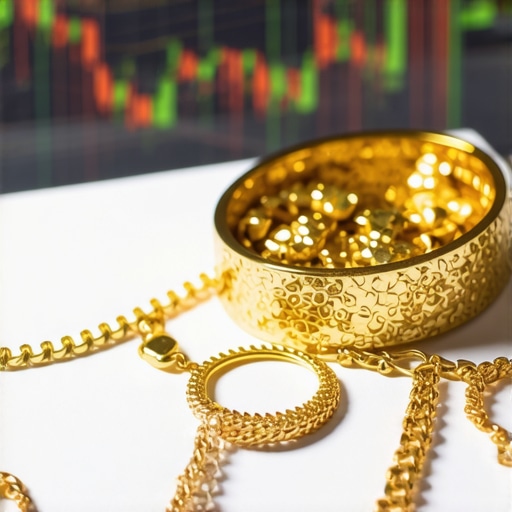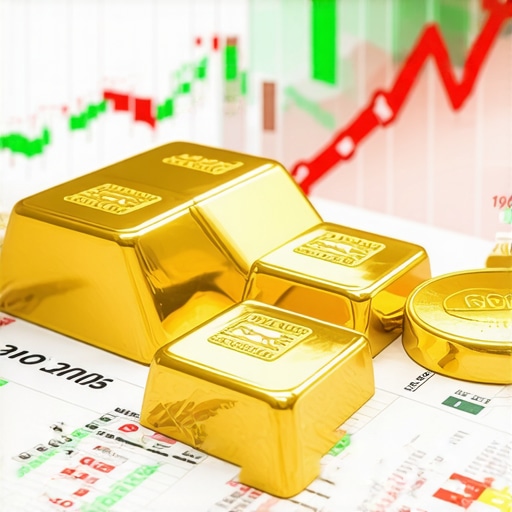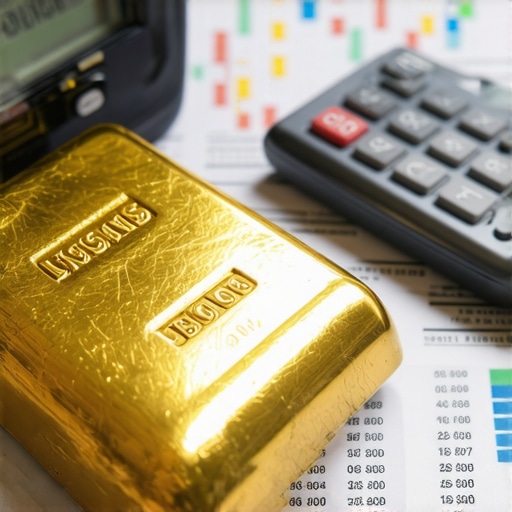Unveiling the Dynamics of Gold Demand: A Strategic Perspective for 2025
As expert analysts forecast the evolution of global markets, understanding the intricate balance between jewelry and industrial demand for gold becomes pivotal. The trajectory of gold prices in 2025 hinges not only on macroeconomic factors but also on nuanced shifts within these sectors, which serve as the backbone of gold’s intrinsic value. This deep dive explores how emerging trends and demand drivers in jewelry and industry will influence gold’s market valuation, emphasizing the importance of a sophisticated investment approach.
Jewelry Sector: The Cultural and Economic Catalysts for Gold Demand in 2025
The jewelry industry remains a primary consumer of gold, accounting for approximately 50% of global demand. Analysts suggest that demographic shifts, evolving consumer preferences, and rising disposable incomes in emerging markets such as India and Southeast Asia will significantly bolster jewelry-related gold consumption. However, geopolitical tensions and supply chain disruptions could introduce volatility, challenging investors to anticipate and hedge against potential price surges or dips.
Industrial Demand: Innovation and Sustainability as Price Catalysts
Gold’s role extends beyond adornment, underpinning critical industrial applications in electronics, aerospace, and medical technology. The push for sustainable and eco-friendly manufacturing practices is expected to influence demand patterns, especially with the advent of new technologies that require high-purity gold. The expansion of 5G infrastructure and electric vehicle production further amplifies industrial demand, potentially exerting upward pressure on prices. Experts emphasize that understanding these technological trends is crucial for predicting price movements.
How Will Fluctuations in Industrial vs. Jewelry Demand Interact to Affect 2025 Prices?
Investors and market strategists are increasingly interested in the interplay between these demand sectors. A divergence—such as a slowdown in jewelry demand amid technological advancements—could be offset by a surge in industrial use, or vice versa. Such dynamics necessitate advanced analytical tools like gold futures technical analysis and demand-supply modeling to accurately forecast future prices. Resources like market insights and forecasts provide essential guidance for navigating this complex landscape.
Expert Insights and Market Outlook for 2025
According to recent market analysis reports, the confluence of rising industrial applications and resilient jewelry demand could propel gold prices to new heights in 2025. However, market volatility remains a concern, particularly with geopolitical uncertainties and global economic shifts. As such, diversifying investments with physical gold, ETFs, or mining stocks—guided by expert strategies—becomes more vital than ever.
For those seeking to deepen their understanding, exploring safe gold investment strategies and leveraging market analysis tools will be critical in aligning portfolios with anticipated demand-driven price movements. The key to success lies in a balanced, informed approach that considers both macroeconomic trends and sector-specific demand signals.
Decoding Future Demand: Will Technological Innovation Shift Gold’s Market Dynamics?
As gold continues to serve as both a precious asset and a technological resource, understanding how emerging innovations influence its demand is vital. The integration of gold in cutting-edge industries—like quantum computing and renewable energy—could redefine its role beyond traditional sectors. These developments not only drive industrial usage but also impact investor sentiment, as the perception of gold’s utility expands into high-tech applications. Experts suggest that tracking advancements in electronics and sustainable technology will be crucial for anticipating price shifts, particularly with the accelerating adoption of green tech and digital infrastructure. For a comprehensive analysis, investors should consider insights from market trend reports that evaluate how these innovations shape demand patterns.
What are the implications of technological demand growth on gold’s long-term investment viability?
The increasing integration of gold in high-tech sectors could boost its value as a strategic asset, especially amid macroeconomic uncertainties. However, this also introduces volatility linked to technological breakthroughs and industry-specific disruptions. Therefore, diversification—such as combining physical gold with ETFs or mining stocks—remains a key strategy. Exploring expert recommendations on investment approaches for 2025 can provide nuanced guidance tailored to these evolving demand drivers.
Is the Gold Market Ready for a Supply Shock? An Investor’s Deep Dive
Supply-side factors, including mining output constraints and geopolitical tensions, are increasingly influencing the gold market. Recent analyses suggest that disruptions in major gold-producing regions—like South Africa and Russia—could trigger supply shortages, thereby amplifying price volatility. Moreover, central bank policies, such as strategic gold reserves accumulation, add another layer of complexity. Understanding these supply dynamics is essential for formulating resilient investment strategies, especially in a climate of heightened geopolitical risks. For detailed insights, reviewing supply-demand analysis reports can help investors navigate potential shocks effectively.
How can investors leverage supply-demand models to preempt market shocks?
Advanced modeling techniques—such as demand-supply equilibrium analysis and futures market strategies—are invaluable tools to anticipate shifts and safeguard investments. Incorporating these models into your portfolio management, alongside expert advice from diversified gold investment strategies, can enhance resilience against unforeseen market movements. Staying informed about geopolitical developments and mining industry trends will further refine your predictive capabilities.
Engage and Expand: Share Your Perspective on Gold’s Future in 2025
Investing in gold involves navigating complex demand-supply interactions, technological innovations, and geopolitical factors. What strategies do you find most effective in mitigating risks and maximizing returns in this dynamic environment? Comment below with your insights or experiences, and share this article with fellow investors seeking to deepen their understanding of gold market trends. For those eager to explore more, consider reading about expert gold price forecasts for 2024 to prepare for upcoming opportunities.
Technological Advancements and Their Dual Impact on Gold Market Stability and Innovation
As the 2025 landscape unfolds, technological innovation continues to serve as both a catalyst for growth and a source of volatility within the gold market. The integration of gold into emerging fields such as quantum computing, renewable energy, and blockchain technology signifies a paradigm shift in demand sources, diversifying gold’s utility beyond traditional sectors. This expansion, however, also introduces complex risks associated with rapid technological changes and industry-specific disruptions, which can influence investor confidence and price stability.
For instance, high-purity gold is now pivotal in the development of quantum processors, where even minuscule variations in quality can impact performance. According to a recent report by the Quantum Technology Review (2025), the demand for ultra-pure gold in such applications is expected to grow exponentially, potentially driving prices upward. Simultaneously, the push towards renewable energy solutions, including large-scale solar panels and green tech batteries, relies heavily on gold’s excellent conductivity and corrosion resistance, further bolstering industrial demand.
How Will Emerging Technologies Reshape Gold’s Investment Narrative in 2025?
Investors must now consider how technological trends influence gold’s role as a safe haven versus a high-tech asset. While the long-term outlook appears promising, characterized by increased industrial demand, the short-term market can experience heightened volatility driven by breakthroughs or setbacks in these sectors. For example, a breakthrough in sustainable electronics could sharply increase gold’s industrial applications, whereas technological failures might temporarily dampen demand. Consequently, leveraging advanced analytical tools—like predictive modeling that incorporates sector-specific innovation indices—is vital for informed decision-making.
Experts recommend diversifying across physical gold, ETFs focused on tech-driven companies, and mining stocks to hedge against these risks. As the Sustainable Investor suggests, aligning your portfolio with emerging tech trajectories can maximize growth potential while mitigating volatility.
Supply Chain Resilience and the Critical Role of Geopolitical Stability
The supply side remains a significant concern, especially with geopolitical tensions intensifying around major gold-producing regions like South Africa, Russia, and Australia. Disruptions in mining operations due to political unrest, environmental regulations, or resource depletion can trigger supply shortages, amplifying price volatility. Recent analyses from the Gold Market Analysis Institute (2025) highlight that strategic reserves and recycling efforts will play an increasingly vital role in balancing supply-demand dynamics.
Furthermore, central banks’ policies toward gold reserves—whether through accumulation or sales—add another layer of complexity. For instance, the recent shift in central bank policies toward diversification away from the US dollar underscores the strategic importance of gold as a geopolitical hedge, influencing both supply and investor sentiment.
Can Advanced Demand-Supply Modeling Safeguard Against Future Shocks?
Absolutely. Employing sophisticated demand-supply models—integrating real-time geopolitical, technological, and environmental data—enables investors to anticipate potential shocks with greater precision. Techniques such as Monte Carlo simulations and scenario analysis, as detailed by Finance Modeling Experts, can simulate a range of market conditions, helping investors develop resilient strategies.
For example, integrating these models with geopolitical risk assessments allows for proactive adjustments in holdings, hedging strategies, or entry/exit timings, ultimately protecting portfolios from sudden market upheavals.
Engage and Share Your Perspective on Gold’s Future Trajectory in 2025
Understanding the multifaceted drivers shaping gold’s market in 2025 is crucial for strategic investment. Which emerging technological sectors do you believe will have the most profound impact on gold demand? How do you plan to incorporate supply chain resilience into your investment approach? Share your insights below and explore further by reviewing detailed forecasts and analytical tools available through trusted market analysis platforms. Staying informed and adaptable will be key to harnessing gold’s potential amid this rapidly evolving landscape.
Deciphering the Complex Interplay of Gold Demand Sectors: A Specialist’s Perspective for 2025
As market analysts delve deeper into the multifaceted landscape of gold economics, it becomes evident that the subtle interactions between jewelry and industrial consumption will critically shape price trajectories. The nuanced shifts within these sectors, driven by technological advances, geopolitical stability, and evolving consumer behaviors, demand sophisticated analytical models that incorporate real-time data and predictive analytics to anticipate future market movements.
Revolutionizing Gold Demand Assessment: The Role of Big Data and AI in Sector Analysis
Emerging technologies such as artificial intelligence and big data analytics are transforming our capacity to forecast gold demand with unprecedented precision. By integrating supply chain data, geopolitical risk indicators, and technological adoption rates, investors can build comprehensive models that dynamically adjust to shifting market conditions, thus enabling more strategic decision-making.
Expert Inquiry: How Can Quantitative Modeling Elevate Investment Strategies in Gold?
Quantitative models utilizing Monte Carlo simulations and scenario analysis provide a robust framework for anticipating potential market shocks and price volatility. Institutions like the Finance Modeling Experts suggest that such models, when calibrated with sector-specific innovation indices, can significantly enhance the resilience of investment portfolios against unpredictable demand fluctuations.
Harnessing Geopolitical and Environmental Data for Strategic Gold Investment
Given the increasing influence of geopolitical tensions and environmental policies on supply chains, integrating these variables into demand-supply models offers a strategic advantage. This approach allows investors to preemptively adjust holdings and hedge against risks associated with regional instability and regulatory shifts, ensuring more stable returns amidst volatility.
Strategic Recommendations for Investors: Embracing Technological and Supply Chain Innovations
To navigate the evolving landscape, investors should diversify across physical holdings, ETFs focusing on technological sectors, and mining equities, leveraging insights from market trend reports and technological adoption forecasts. This multi-pronged strategy mitigates exposure to sector-specific disruptions while capitalizing on emerging demand sources.
Future Outlook: The Convergence of Innovation and Geopolitical Stability in Gold Markets
Looking ahead, the integration of high-tech applications in quantum computing, renewable energy, and blockchain will redefine gold’s role in the global economy. Simultaneously, maintaining geopolitical stability and resilient supply chains will be essential for sustaining market confidence and price stability. Continuous monitoring of technological breakthroughs and geopolitical developments, coupled with advanced demand-supply modeling, will empower investors to capitalize on emerging opportunities in 2025.
Call to Action: Elevate Your Investment Strategy with Cutting-Edge Analytical Tools
For professionals seeking to deepen their understanding and refine their investment approaches, exploring advanced predictive analytics, real-time data integration, and sector-specific innovation indices is imperative. Engage with industry reports, participate in expert forums, and leverage sophisticated modeling techniques to stay ahead in the competitive gold market landscape of 2025. The future favors those equipped with knowledge, agility, and strategic foresight.
Expert Insights & Advanced Considerations
1. The Interplay of Jewelry and Industrial Demand Shapes Market Volatility
Understanding the nuanced relationship between jewelry consumption and industrial applications is crucial for predicting gold price movements. Experts highlight that shifts in technological innovation, consumer behavior, and geopolitical stability can cause significant demand fluctuations, requiring investors to utilize sophisticated analytical tools like demand-supply modeling and futures market analysis.
2. The Role of Emerging Technologies in Diversifying Gold Demand
Advances in sectors such as quantum computing, renewable energy, and blockchain are expanding gold’s utility beyond traditional uses. These technological trends are anticipated to drive industrial demand upward, but also introduce volatility due to rapid innovation cycles. Staying informed through sector-specific innovation indices is vital for strategic positioning.
3. Geopolitical Stability and Supply Chain Resilience as Market Stabilizers
Disruptions in major mining regions and shifts in central bank policies are key factors influencing supply. Experts recommend leveraging demand-supply models incorporating geopolitical risks and environmental policies to anticipate shocks and develop resilient investment strategies, including diversification across physical gold and mining stocks.
4. The Significance of Big Data and AI in Demand Forecasting
Integration of artificial intelligence and big data analytics enhances predictive accuracy for demand trends. Quantitative models, such as Monte Carlo simulations, enable investors to simulate various scenarios, providing a strategic edge in volatile markets.
5. Strategic Diversification as a Risk Mitigation Tool
Combining physical gold, ETFs focusing on technological sectors, and mining shares is recommended to hedge against sector-specific disruptions. Continuous monitoring of technological breakthroughs and geopolitical developments is essential for maintaining a competitive investment position.
Curated Expert Resources
- Gold Market Analysis Reports: These provide comprehensive insights into current trends, demand drivers, and future price forecasts, essential for informed decision-making.
- Sector-Specific Innovation Indices: Tracking technological advancements helps anticipate shifts in industrial demand and identify emerging opportunities.
- Demand-Supply Modeling Tools: Advanced analytical platforms enable scenario planning and risk assessment, crucial for managing volatility.
- AI and Big Data Analytics Platforms: These tools enhance demand forecasting accuracy by integrating diverse data sources including geopolitical and environmental factors.
- Authoritative Industry Forums and Publications: Engaging with expert communities fosters deeper understanding of market dynamics and strategic insights.
Final Expert Perspective
As the landscape of gold demand in 2025 evolves with technological innovation and geopolitical shifts, a sophisticated, data-driven approach becomes indispensable. The integration of demand-supply analytics, AI forecasting, and diversified investment strategies empowers investors to navigate volatility effectively. For those committed to long-term success, leveraging these advanced insights and resources will be the defining factor in capitalizing on gold’s enduring value. Engage with industry reports, participate in expert forums, and continuously refine your analytical toolkit to stay ahead in this dynamic environment.










